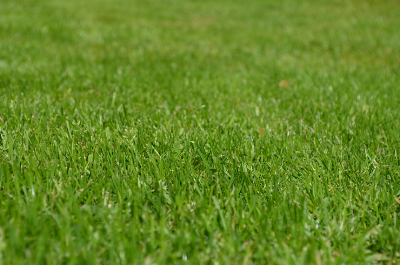
As far as gardening goes, having a lovely lawn is the first step for most people. If we can crack it, the rest (blossoming flower beds, a bountiful vegetable patch) will soon follow. But many of us fall at the first hurdle when we look out at a brown, patchy lawn.
But don’t give up!
Growing a lush lawn is easy, but only when you know how. Follow our 7 easy steps and your lawn will be beautiful with very little effort.
TIP 1 – RESEED

One thing to remember about Mother Nature is that she wants to grow things even more than you do. Which means that any bare or patchy areas attract weeds whether you like it or not. If grass isn’t growing, that patch will soon be weeds.
So reseed any bare or patchy areas to fill them with the grass you want, not the weeds you don’t. And while you’re at it, if your lawn is generally looking a little thin, overseed the entire area. This will create a thicker lawn.
TIP 2 – MOW

Mow your lawn once a week during the spring and summer. This encourages new growth and keeps it looking fresh. But don’t forget the two golden mowing rules, keep it long and keep them sharp.
· Cut only 1/3 of the length at each mow. This allows for new growth while not stripping the lawn of all its nutrients.
· Keep your blades sharp. Mowing a lawn with a dull blade will leave the ends ragged, and they will turn brown. Keep your mower in top condition by servicing it yearly. If you have a robotic lawnmower, blades can be replaced during the service.
TIP 3 – MULCH CLIPPINGS

While we’re on the subject of mowing, don’t waste all those lovely nutrients in your grass clippings! Experts (who keep golf courses and playing fields healthy) know that the best fertiliser is grass clippings. All robotic lawnmowers mulch the clippings. In layman’s terms, the clippings get cut up into tiny pieces and then deposited back onto the surface of the lawn. These rot down, sending powerful nutrients to the roots, helping it to grow thick and healthy.
TIP 4 – AERATE

A good lawn gets used. Kids and pets play on it, we walk on it, sit on it, maybe even roll about on it. And all this action can squish the soil and make it hard and dense. Compacted soil prevents water, oxygen and nutrients from getting to the roots of the grass. Aerating the lawn loosens the soil and makes space for all the good stuff to get in.
Aerating is simple and should happen once in the spring and once in the autumn, depending on how compacted your lawn is. And it doesn’t have to be costly, a garden fork will do the job as well as a commercial aerator.
1. Mow the lawn and use a rake or scarifier to remove any thatch.
2. Start at one corner of the lawn and push the fork straight down into the grass, so that the tines go in at their full length.
3. Repeat every 4-6 inches across the whole lawn. 4. Sweep over sand to fill the holes and water well.
TIP 5 – ALTERNATE THE MOWING DIRECTION

We often look at perfect striped lawns with envy, but the truth is, such a strict mowing pattern isn’t good for the lawn. Mowing in the same direction week after week will eventually cause the turf to lay flat and it won’t spring back. And while you may not notice the wheels of your mower causing ruts, your grass will. Mowing in a random pattern will ensure all the grass is evenly cut while promoting a healthy lawn. Robotic lawnmowers mow in a random pattern, experts agree this is an important factor in a healthy lawn.
TIP 6 – FERTILISE

Cutting the grass removes nutrients, even if you mulch religiously. We recommend you fertilise your lawn every 4-5 weeks during growing season. This replaces the nitrogen, phosphorous and potassium lost during summer. Follow manufacturers directions, but here are some tips to ensure you get the best out of the process.
· Where possible, apply fertiliser right after mowing.
· Apply fertiliser before it rains to help it get to the roots.
· If it has been dry wait until there has been some rain, because fertiliser can scorch parched lawns.
· Apply 1/3 less fertiliser in shady areas.
TIP 7 – WATER

Are you watering your lawn wrong? Yep, it is possible. Watering your lawn in the evening (especially in the UK where sunshine is lacking) can lead to rot. This is because the water stays on the blades too long. Water your lawn early in the morning. This will allow the sun to dry off the blades so that the grass gets the liquid it needs without becoming sodden.
Having a beautiful lawn isn’t out of reach, even if you’re a complete novice to the world of gardening. Follow our easy tips and you’ll love your lawn in no time.









